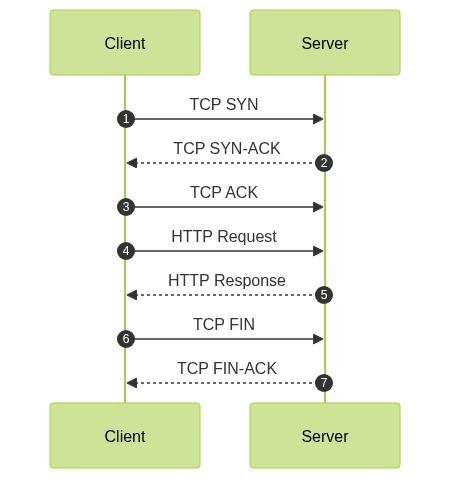Introduction
When building networked applications or understanding how internet communication works, knowing the difference between TCP and HTTP is crucial. The term "tcp vs http" often surfaces in developer discussions, but the distinction isn’t always clear. TCP (Transmission Control Protocol) and HTTP (Hypertext Transfer Protocol) are both foundational to modern networking, but serve very different purposes. In this post, we’ll break down their roles, how they fit into the OSI model, their key differences, how they work together, and provide code examples you can try in 2025.
Understanding TCP and HTTP
What is TCP?
TCP, or Transmission Control Protocol, is a core protocol of the Internet protocol suite, operating at the transport layer of the OSI model. Its primary job is to provide reliable, ordered, and error-checked delivery of data between applications running on hosts communicating via an IP network. TCP handles packet transmission, data integrity, and manages connections via a handshake process.
If you're developing custom communication tools or integrating advanced features like a
phone call api
, understanding TCP's reliability and control is essential.Here’s a simple example of establishing a TCP connection in Python using the
socket module:1import socket
2
3HOST = '127.0.0.1' # Localhost
4PORT = 65432 # Arbitrary non-privileged port
5
6with socket.socket(socket.AF_INET, socket.SOCK_STREAM) as s:
7 s.connect((HOST, PORT))
8 s.sendall(b'Hello, TCP server!')
9 data = s.recv(1024)
10 print('Received', repr(data))
11What is HTTP?
HTTP, or Hypertext Transfer Protocol, operates at the application layer of the OSI model. It is the protocol that powers the web, defining how messages are formatted and transmitted, and how web servers and browsers should respond to various commands. HTTP uses TCP as its underlying transport, leveraging TCP’s reliability for the delivery of web resources.
Many modern applications, such as those using a
Video Calling API
, rely on HTTP for signaling and session management, while actual media streams may use additional protocols for efficiency.Here’s a simple HTTP GET request in Python using the
requests library:1import requests
2
3response = requests.get('https://example.com')
4print(response.status_code)
5print(response.text)
6TCP vs HTTP: Layered Architecture
Understanding where TCP and HTTP fit in the OSI (Open Systems Interconnection) model is foundational to the tcp vs http discussion. The OSI model is a conceptual framework used to understand network interactions in seven layers.
- TCP operates at the transport layer (Layer 4), handling end-to-end data transmission and reliability.
- HTTP works at the application layer (Layer 7), providing rules for how web content is requested and delivered.
For developers building solutions like a
Live Streaming API SDK
, it's important to recognize how these protocols interact within the network stack to ensure seamless media delivery.The protocols form part of a stack, where HTTP data gets encapsulated inside TCP segments for transmission.

This diagram illustrates how HTTP relies on TCP to send data over the network.
Key Differences Between TCP and HTTP
Protocol Type and Purpose: TCP vs HTTP
TCP is a transport protocol designed to facilitate reliable network communication between devices. It focuses on data transport, sequencing, and error checking. HTTP, on the other hand, is an application protocol for requesting and sharing web data, such as HTML, images, and APIs. In tcp vs http, TCP provides the channel, while HTTP defines the message.
If you're developing cross-platform communication tools, you might consider using
flutter webrtc
to build real-time video and audio features that leverage these protocols.Connection Management: Stateful vs Stateless (TCP vs HTTP)
TCP is stateful—it establishes and maintains a connection through a handshake (SYN, SYN-ACK, ACK), keeping track of session state throughout communication. HTTP is stateless—each request/response pair is independent, and the protocol itself doesn’t retain session information between interactions. This is a major distinction in tcp vs http.
For Android developers,
webrtc android
implementations often use TCP for signaling and HTTP for RESTful APIs, while media streams may use UDP for lower latency.Data Transmission and Reliability: TCP vs HTTP
TCP ensures reliable data transmission through acknowledgements (ACKs), retransmissions, and sequencing. This guarantees that data arrives intact and in the correct order. HTTP, being built on top of TCP, relies on TCP for transmission reliability but doesn’t add its own mechanisms for reliability.
If you want to
embed video calling sdk
into your web or mobile app, understanding TCP's role in ensuring data reliability is crucial for high-quality calls.Ports and Default Usage: TCP vs HTTP
TCP can use a variety of port numbers depending on the application. HTTP, by default, uses TCP port 80 (and HTTPS uses 443).
For developers working with JavaScript, leveraging a
javascript video and audio calling sdk
can simplify the process of building real-time communication features that operate over these standard ports.Security Implications: TCP vs HTTP
TCP itself is unencrypted by default. HTTP is also plaintext, but security is achieved via HTTPS, which is HTTP over TLS/SSL and still relies on TCP.
How TCP and HTTP Work Together
In the tcp vs http context, HTTP requests are encapsulated within TCP segments for transport. This encapsulation lets HTTP leverage the reliability and connection management features of TCP.
Here’s a step-by-step flow of a typical web request:
- TCP handshake establishes a connection between client and server.
- HTTP request is sent from the client to the server over TCP.
- Server processes the request and sends an HTTP response back over the same TCP connection.
- TCP connection is closed (or reused, depending on keep-alive).
If you're building cross-platform solutions, using a
python video and audio calling sdk
can help you implement robust communication features that utilize both TCP and HTTP layers.Visualized as a sequence diagram:

Real-World Use Cases: TCP vs HTTP
When considering tcp vs http for network communication, the use case typically determines which protocol (or combination) is appropriate.
- Direct TCP: Ideal for custom applications needing low-level control, such as game servers, streaming, or file transfers (FTP uses TCP). For example, building a scalable
Video Calling API
for enterprise communication often requires both direct TCP connections and HTTP-based signaling. - HTTP: Suited for web browsing, REST APIs, and web services where standardized request/response is critical.
| Use Case | TCP Directly | HTTP (Over TCP) |
|---|---|---|
| Web Browsing | ✗ | ✓ |
| File Transfer (FTP) | ✓ | ✗ |
| Streaming (RTSP) | ✓ | ✗ |
| REST APIs | ✗ | ✓ |
| Custom Network Protocols | ✓ | ✗ |
Code Examples: TCP vs HTTP in Action
Simple TCP Client/Server Example (Python)
Here’s a minimal TCP server and client example in Python for tcp vs http illustration:
TCP Server:
```python
import socket
HOST = '127.0.0.1'
PORT = 65432
with socket.socket(socket.AF_INET, socket.SOCK_STREAM) as s:
s.bind((HOST, PORT))
s.listen()
conn, addr = s.accept()
with conn:
print('Connected by', addr)
data = conn.recv(1024)
conn.sendall(b'Hello, TCP client!')
```
TCP Client:
```python
import socket
HOST = '127.0.0.1'
PORT = 65432
with socket.socket(socket.AF_INET, socket.SOCK_STREAM) as s:
s.connect((HOST, PORT))
s.sendall(b'Hello, TCP server!')
data = s.recv(1024)
print('Received', repr(data))
```
Simple HTTP Request Example (Python)
Sending an HTTP request (tcp vs http in action) is even easier using the
requests library:1import requests
2
3response = requests.get('https://jsonplaceholder.typicode.com/todos/1')
4print(response.json())
5If you're interested in hands-on experimentation, you can
Try it for free
with modern communication SDKs to see how TCP and HTTP power real-time applications.Common Misconceptions and Best Practices: TCP vs HTTP
A frequent misconception is that TCP and HTTP are alternatives—they are not. Instead, HTTP depends on TCP for data transport. Choosing between TCP vs HTTP depends on your application requirements:
- Don't use HTTP for real-time streaming or protocols requiring custom packet handling. Use TCP or even UDP directly.
- Don't use raw TCP for web content or APIs—you'll lose key features like routing, caching, and standardized formats.
- Best practice: Understand your data, reliability, and performance needs before choosing tcp vs http for your software architecture.
Conclusion: Choosing Between TCP and HTTP
In the tcp vs http landscape, TCP is the reliable transport engine, while HTTP defines web communication semantics. For most web or API projects in 2025, HTTP over TCP is the default. Choose raw TCP for low-level, custom, or performance-critical network applications.
Want to level-up your learning? Subscribe now
Subscribe to our newsletter for more tech based insights
FAQ